Last week I examined the limitations of Canada’s new Defence Procurement Strategy (DPS). Specifically, I highlighted the DPS’ requirement of suppliers to enhance Canada’s export potential as part of the new Industrial and Technological Benefits (ITB) policy. However, in consideration of US bans on the re-export of certain US defence technology and technical data under the US State Department’s International Traffic in Arms Regulations (ITAR), Canada does not have authority to export defence technology and data it has obtained from the US to foreign countries. Therefore, US suppliers may not provide Canada with significant export potential, in stark contrast to the requirements of Canada’s new ITB policy, which may complicate or entirely preclude US suppliers from competing for DND contracts. Considering that the Canadian defence industry faces challenges relating to economies of scale and lacks the calibre and scope of capabilities of the US defence industry, relying on Canadian defence suppliers to produce significant military equipment would result in the procurement of more expensive and less advanced equipment than could be sourced from abroad.
[captionpix align=”left” theme=”elegant” width=”300″ imgsrc=”http://natoassociation.ca/wp-content/uploads/2014/02/919077_10151574700014802_1474799562_o.jpg”]
Canada’s new DPS consists of generalized objectives including “the delivery of the right equipment to the Canadian Forces and the Canadian Coast Guard, leveraging defence procurement to create jobs and economic growth, and streamlining the defence procurement process”. Within these three core objectives, the DPS includes proposals for the creation of a Defence Acquisition Guide to forecast the equipment needs and general outlook of the Canadian Forces over the next twenty years, implementing an Export Strategy to support international sales, and the establishment of a Defence Analytics Institute to provide sound technical expertise to bureaucrats.
Substantial detail regarding the various offices’ management structures, responsibilities and how each of their outputs will weave together to form a coherent new procurement strategy remains to be determined. Although the DPS’ departments, official representatives, internal hierarchies and intended policy outcomes are yet to be consolidated, the formal announcement of a renewed DPS marks a new beginning in procurement and is a step in the right direction for Canada. The DPS is still in its early stages and technical shortfalls will surely be rectified as the strategy is further shaped.
The announcement of a new DPS includes promises to streamline the evaluation and acquisition process by unifying bureaucratic elements from the Department of National Defence (DND), Industry Canada, Public Works and Government Services Canada (PWGSC), and various independent advisors into a Secretariat, which will report to PWGSC. In doing so, the DPS will be effective at least to the extent that it increases accountability by concentrating oversight authority in one federal department, enabling scrutiny of the appropriate authorities in the event of significant procurement errors. Management centralization is also presumed to eliminate or at least reduce the likelihood of policy divergence, miscommunication, and other complications inherent to Canada’s compartmentalized procurement model. By implementing a revised DPS, the current government has acknowledged that defence procurement must undergo fundamental changes in order to avoid further squandering billions of taxpayer dollars in unrealized acquisitions. This is in contrast to previous governments’ ignorance of the bureaucratic impairments that exist within Canada’s procurement paradigm.
[captionpix align=”left” theme=”elegant” width=”300″ imgsrc=”http://natoassociation.ca/wp-content/uploads/2014/02/AIR_F-35A_and_F-18C.jpg”]
Defence procurement in Canada has been thwarted not simply by bureaucratic pitfalls but considerable political ones as well. Past governments have invested financial, material and human capital resources into fighter jet, rescue helicopter, and land vehicle procurements. These have been delayed or cancelled as a result of successor governments abandoning their contractual obligations to purchase military equipment from industry suppliers. As a result, Canada has suffered enormous financial penalties and magnified long-term procurement costs by having to reinitiate bids for equipment. Specifically, in the case of ship-borne helicopters, which to this day remains unsettled and constitutes an unprecedented thirty-year odyssey of cancellations, lawsuits and re-bids, Canada was forced to pay $500 million in fines after the Chrétien government cancelled the acquisition plan of the Mulroney government. Considering that much of the Canadian Forces’ equipment is rapidly approaching replacement age, a revised DPS is more critical than ever before. The consolidation of such a policy framework should include provisions to require empirical justification for executive cancellations.
The consensus among Canadian government officials, the Canadian Forces, academia, defence industry representatives, media, and Canadians suggests a need for a revised procurement strategy. The DPS should be implemented as expeditiously as possible to allay interdepartmental discord and political pettiness from Canada’s elected officials. Once the organizational structure of the Secretariat has been consolidated, the new DPS will ensure greater national security for current and future generations of Canadians.




